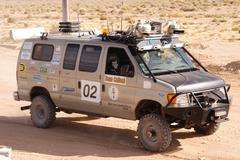Alice on Trial, Redux

When Alice revs her engine at the start of the Defense Advanced Research Projects Agency (DARPA) Urban Challenge qualifying rounds on October 27, multitudes of cameras will be pointing at her. But she'll only care about the eight cameras that will be facing away.
Alice is the tricked-out Ford E-350 van that has been revamped to autonomously navigate the vagaries of an urban setting. To do so, she sports eight cameras that feed information to computers at rates of hundreds of megabits per second. Six of those cameras face forward, one faces the rear, and one is mounted on a pan-tilt unit programmed to turn and look to the left and to the right.
Team Caltech leader Richard Murray, Everhart Professor of Control and Dynamical Systems, says there's good reason the team chose a setup in which several cameras and lasers feed visual information into decentralized computers. With multiple computers telling Alice about surrounding obstacles, "it's like having multiple parts of your brain telling you what to do," he says. The computers are arranged in a hierarchy, with "lower level" computers doing computations based on the information they receive and passing on results to higher levels, where the ultimate decision is made. This way, there's less chance of driving into an obstacle and more chance of staying on the path the cameras detect. Team Caltech also chose this setup because it could easily accommodate new sensors.
The Urban Challenge presents far greater complexities than the two previous Grand Challenges, which took place in the desert of Barstow, California. "In the desert challenge, you simply had to drive on flat spots," Murray says. The teams have road information from aerial photos and maps of this year's challenge site, a mock city at the George Air Force Base in Victorville, California. But, says Murray, "that's not the hard part. It's dealing with what's not on the map. We don't know where there will be obstacles or where other vehicles will be."
Team Caltech's attempts at winning the first two DARPA challenges were met with defeat. In 2004, Alice's predecessor Bob drove 1.3 miles before losing a fight with a barbed-wire fence. In communications theory, Alice and Bob stand for sender and receiver, so the next year, Bob gave way to Alice, who ended an eight-mile run at a concrete barrier. Now, Alice, redux, is one of 35 vehicles entering the qualifying round for this year's Urban Challenge. Murray is confident Team Caltech will advance to the final round, on November 3.
What makes the new challenge so difficult is not news to any driver--the rules come from the California driver's handbook. Any collision or damage wreaked gets the team automatically disqualified. Broken rules like turning without signaling or crossing a solid traffic line incur a time penalty. Each team will vie with up to 34 other vehicles that may qualify for the race, and DARPA may make things even trickier by including human-driven vehicles.
It would be impossible to imagine and prepare for every error that pops up, says Murray. Instead, he says, the team took the approach of following a sequence of actions to try to solve any dilemma. For example, if there were dirt on one sensor the computers might mistake it for a real obstacle. Then Alice might try backing up to check if the obstacle remained. The Jet Propulsion Laboratory (JPL) uses some of these approaches in building its autonomous rovers to explore other planets' surfaces. "Part of the approach we take is to build on what JPL has been doing for years," Murray says.
The Caltech team consists of almost 80 undergraduate and graduate students, postdocs, and faculty, many of whom participated in the previous Grand Challenge. Specialists from JPL and Northrop Grumman added their expertise. In the final event, the team whose vehicle reaches the finish line first in less than six hours wins $2 million, second place garners $1 million, and third, $500,000.
Source: Caltech





















